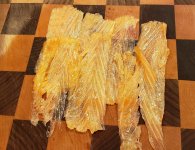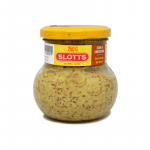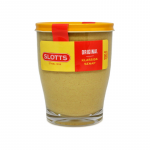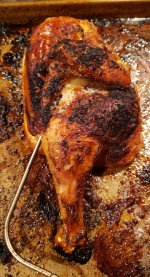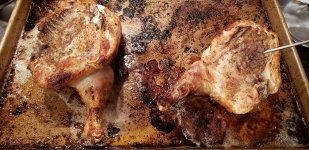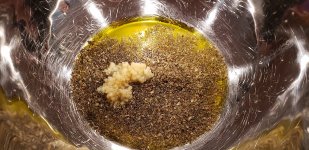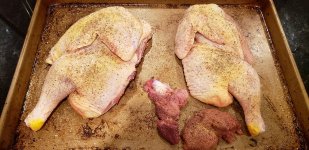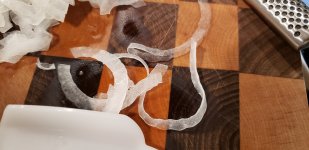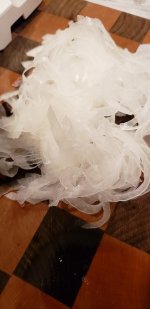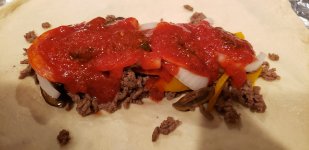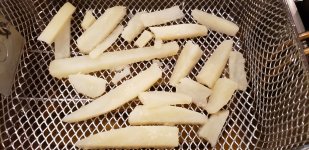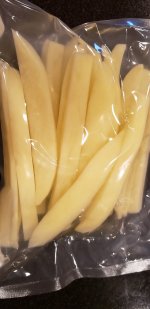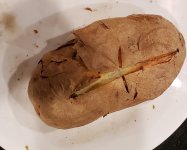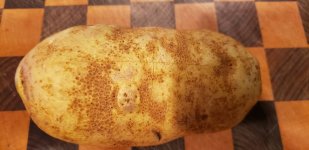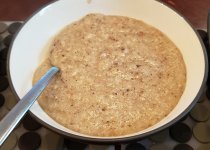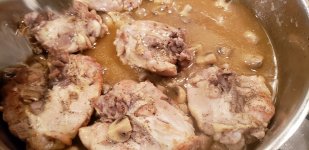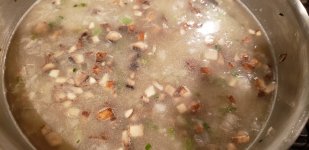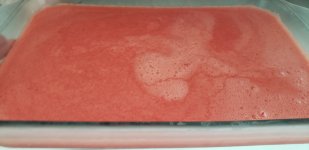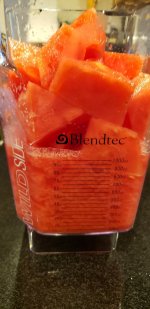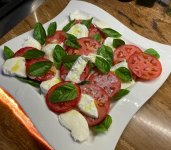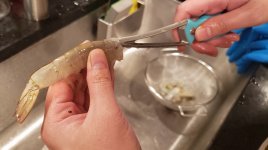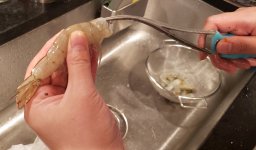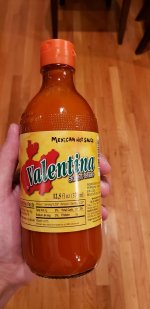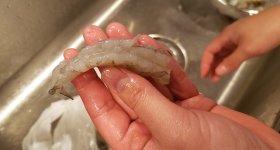hdv
Member
OK, this is adapted from recipes I found in Bonniers Stora Kokbok, an old Swedish recipe I got from friends, and a cookbook from Anna Mosesson.
1 kilo Salmon, de-boned and descaled, but with skin (*)
4 tablespoons salt (**)
4 tablespoons white sugar
2 tablespoons freshly crushed white pepper corns
300 gr fresh dill
(*) It is best to have 1 large piece that is cut in two along the bone so you end up with two symmetric parts
(**) This is just my opinion, but salt is salt. There is no "more" or "less" salty salt. What can differ is the additives in refined salt (here most salts have added iodine, unlike kosher salt) or the trace amounts of other minerals (like sulfate, magnesium and calcium) in rock salt or sea salt.
- Mix the salt, sugar, and pepper
- Thoroughly rinse the dill and swing it a few times to get most of the water off again
- Chop 2/3 of the dill
- Sprinkle one third of the salt mix in a dish
- Put the first half of the salmon in the dish, with the skin down
- Sprinkle the chopped dill on the salmon
- Sprinkle another third of the salt mix on the salmon and dill
- Put the second half of the salmon with the skin up on the first piece of salmon
- Sprinkle the last third of the salt mix over the salmon
- Cover with foil
- Put a plate on top of the foil
- Put some extra weight on the plate (2 or 3 cans will do)
- Place in the refrigerator
- Turn every 12 hours and pour the liquid from the dish over and between the fish
- Do this for at least 24 hours, but no more than 48 hours (depending on your taste)
- Remove the spices and herbs from the fish
- Use kitchen towels/paper to dry the fish
- Cut in thin slices (tradition dictates this should be done under 45 degrees)
- Chop the last third of the dill
- Sprinkle the dill on the salmon
- Enjoy your gravad lax
Of course, gravad lax must be served with hovmästersås (mustard-dill sause)!
BTW, this dish is called gravad lax (buried salmon in a loose translation) because in the past the Swedes used to bury the fish in the ground while letting it cure.
[member=44099]Cheese[/member]: all the "authentic" recipes I know always use a ratio of about 1:1 for the salt and sugar. But you are right about the curing times. This is just like curries and other traditional family recipes. Every family will do this their own way. The longer you let the fish cure, the more salt it will absorb. Like I said in a previous post, Swedes do like their food quite salty. So that is something to keep in mind. I myself let the fish cure for about 36 hrs (according to my notes, it's been a while since I made this dish). Their other vice is sugar. If you ever go to Sweden, try to visit a candy store. You'll never know what hit you! There can be literally rows upon rows of different types of candy, chocolate, and other sweets. I think I read somewhere that the largest candy store in the world is located in Sweden. I wouldn't be surprised if that were true!
1 kilo Salmon, de-boned and descaled, but with skin (*)
4 tablespoons salt (**)
4 tablespoons white sugar
2 tablespoons freshly crushed white pepper corns
300 gr fresh dill
(*) It is best to have 1 large piece that is cut in two along the bone so you end up with two symmetric parts
(**) This is just my opinion, but salt is salt. There is no "more" or "less" salty salt. What can differ is the additives in refined salt (here most salts have added iodine, unlike kosher salt) or the trace amounts of other minerals (like sulfate, magnesium and calcium) in rock salt or sea salt.
- Mix the salt, sugar, and pepper
- Thoroughly rinse the dill and swing it a few times to get most of the water off again
- Chop 2/3 of the dill
- Sprinkle one third of the salt mix in a dish
- Put the first half of the salmon in the dish, with the skin down
- Sprinkle the chopped dill on the salmon
- Sprinkle another third of the salt mix on the salmon and dill
- Put the second half of the salmon with the skin up on the first piece of salmon
- Sprinkle the last third of the salt mix over the salmon
- Cover with foil
- Put a plate on top of the foil
- Put some extra weight on the plate (2 or 3 cans will do)
- Place in the refrigerator
- Turn every 12 hours and pour the liquid from the dish over and between the fish
- Do this for at least 24 hours, but no more than 48 hours (depending on your taste)
- Remove the spices and herbs from the fish
- Use kitchen towels/paper to dry the fish
- Cut in thin slices (tradition dictates this should be done under 45 degrees)
- Chop the last third of the dill
- Sprinkle the dill on the salmon
- Enjoy your gravad lax
Of course, gravad lax must be served with hovmästersås (mustard-dill sause)!
BTW, this dish is called gravad lax (buried salmon in a loose translation) because in the past the Swedes used to bury the fish in the ground while letting it cure.
[member=44099]Cheese[/member]: all the "authentic" recipes I know always use a ratio of about 1:1 for the salt and sugar. But you are right about the curing times. This is just like curries and other traditional family recipes. Every family will do this their own way. The longer you let the fish cure, the more salt it will absorb. Like I said in a previous post, Swedes do like their food quite salty. So that is something to keep in mind. I myself let the fish cure for about 36 hrs (according to my notes, it's been a while since I made this dish). Their other vice is sugar. If you ever go to Sweden, try to visit a candy store. You'll never know what hit you! There can be literally rows upon rows of different types of candy, chocolate, and other sweets. I think I read somewhere that the largest candy store in the world is located in Sweden. I wouldn't be surprised if that were true!

